People who know me know I have a problem. I collect old BMWs, specifically the models fewer people care about. I have had E3 (the Bavarias) and E12 (the first 5 Series) sedans, as well as one garden-variety 1985 535i. Anything with an ‘M’ prefix? Nope. A beautiful CS coupe? Not yet. The iconic 2002? One, briefly, in ‘tii’ form though I never drove it because the burning oil fumes would get sucked into the cabin through the rotted spare tire well.
I don’t care, because the cars that have stuck around are like family members. Like Max the 1972 Bavaria and Chuck the 1981 528i, owned 12 and 10 years, respectively.
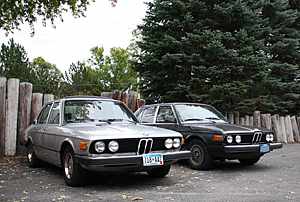 Relatively recently, we shipped the 528i from California to its new home in Minnesota. While it is straight and rust-free, and sports a freshly-rebuilt 3.5-litre engine, Chuck has lots of needs. And those needs, apparently, required a donor. Enter one 1976 530i, also known as Sam the rusty parts car, purchased over the summer and driven around since.
Relatively recently, we shipped the 528i from California to its new home in Minnesota. While it is straight and rust-free, and sports a freshly-rebuilt 3.5-litre engine, Chuck has lots of needs. And those needs, apparently, required a donor. Enter one 1976 530i, also known as Sam the rusty parts car, purchased over the summer and driven around since.
Recently, however, Sam shuffled off his mortal coil due in no small part to the liberal application of wrenches and sockets. Yes, it was time for him to donate his remaining worthy bits for the potential betterment of the other children. Kind of like the Donner party, but with a transmission and dashboard instead of legs and a spleen.
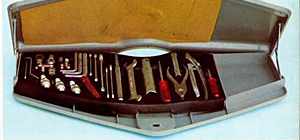 Not that I used them to render Sam into his elemental pieces, but it still amazes me the damage you can do to a BMW with the hand tools found in the old tool kits. An acre of Heyco and Hazet tools hanging in their happy plastic tray. The coveted red-handled screwdrivers and no-longer-available blue cleaning rag, the feeler gauge set, those lovely channel locks. Nobody knows why the pliers were shiny chrome while all the other tools were satin finished. The newer tool kits are sad by comparison, offering a screwdriver, a wrench, and… I think that’s it.
Not that I used them to render Sam into his elemental pieces, but it still amazes me the damage you can do to a BMW with the hand tools found in the old tool kits. An acre of Heyco and Hazet tools hanging in their happy plastic tray. The coveted red-handled screwdrivers and no-longer-available blue cleaning rag, the feeler gauge set, those lovely channel locks. Nobody knows why the pliers were shiny chrome while all the other tools were satin finished. The newer tool kits are sad by comparison, offering a screwdriver, a wrench, and… I think that’s it.
Today, you could maybe pop off the cover for the tow hook receiver with the screwdriver or hit yourself on the nose with the one little wrench. But back then you could dismantle about 90% of a 2002 or Bavaria with only those tools that came with the car. Indeed, the only tool able to reach the upper starter bolt on an early M30 six-cylinder is the 17mm/19mm open-end combination wrench in the toolkit.
Sam had a good tool kit, complete with the aforementioned red-handled screwdrivers. Sam had lots of other good parts, too, including the interior, fuel injection and all the parts to convert an automatic-transmissioned E12 5 Series to manual. During the 10-hour marathon in which I gutted Sam like a fish, my mind wandered back to other cars who gave of themselves so others may someday live.
My uncle had a very rusty Datsun 610 station wagon. How rusty, you ask? The front fender bottoms flapped in the breeze, for which my poor cousin got a ticket in Vermont. At the time I had a Datsun 510 wagon, so when my uncle was done with his car he gave it to me to part out. I took the 1.8-liter engine and four-speed to replace the 1.6-liter and automatic in my 510. I took the pedal box, the nice interior, and a lot of the trim. Guess what? None of those things except the L18 engine fits a 510. All the parts were shelved.
A short time later, I had a 1980 Volkswagen Rabbit convertible. The same uncle had a 1977 Rabbit diesel. The diesel died after the dolts at Dummy Lube cross-threaded the oil filter which caused all the oil to fall out while my aunt was driving home. The car landed at my house and I poached parts like the kilometers-per-hour speedometer (the diesel was a Canadian car) and the squishy horn pad. When the bunny started leaking diesel fuel on the driveway it got hauled away, filled with Datsun 610 parts.
The first BMW I dismantled was a 325e that had been punted hard in the rear. It came apart pretty well, but the real significance here was the learning curve. It turns out that most BMWs from the early Neue Klasse sedans to the later E38 7ers and E39 5ers come apart and go together in eerily similar ways. That 325e was also the first car I ever chopped up with a Sawzall.
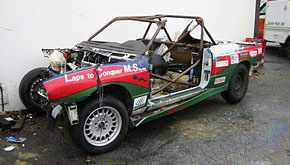 It was shortly thereafter I parted out an E30 M3 that had barrel-rolled at the track. Dismantling and Sawzall duties were shared with a very attractive young red-haired lady named Tatiana. Later, there was another E30 M3 race car that had been stuff hard into a wall. Ever try to cut the roof off a car while working around a roll cage?
It was shortly thereafter I parted out an E30 M3 that had barrel-rolled at the track. Dismantling and Sawzall duties were shared with a very attractive young red-haired lady named Tatiana. Later, there was another E30 M3 race car that had been stuff hard into a wall. Ever try to cut the roof off a car while working around a roll cage?
I should mention that, with the possible exception of fire, the Milwaukee Sawzall is the best tool ever devised by man. There are other reciprocating saws, made by reputable companies like Dewalt and Bosch, but there is only one Sawzall. And unlike when a person says they want a Band-Aid or a Kleenex in reference to an adhesive bandage or something in which to catch boogers, when someone says they want a Sawzall they only want a Milwaukee Sawzall.
Next came a 1989 325i with a washed title, a nightmare salad of two or three cars glued together. It started life as a black-on-black four-door. However, under the respray the roof and passenger side b-pillar were silver and the passenger side doors were red. The owner was a client who had bought the car sight unseen out of Los Angeles. We discovered its origins when he complained the car leaked in the rain. Of course it did; when the artists had welded on the new roof they had not bothered to reinstall the sunroof drain tubes. After the client put entirely too much money into almost every repair you can perform on an E30, he finally gave up and gave us the car. My fourth adventure with a Sawzall.
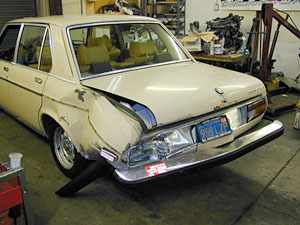 I have killed only three Bavarias in my time. The first was a worn-out 1972 whose long-term owner lived at the end of a dirt road. When we chopped it up we had more earth than metal. The second was a 1974 which was rear-ended by a Volkswagen Jetta doing 50 MPH. Despite an accordioned left rear corner and buckled transmission tunnel, all four doors still opened and closed. Indeed, once we pried the wheel arch off the tire, we were able to drive the car. The third and hopefully last E3 to die by my hands was a horribly rusty Minnesota parts car. This car taught me that even the firewalls on a Bavaria can rot away. When I chopped that one up, I had more rust than metal.
I have killed only three Bavarias in my time. The first was a worn-out 1972 whose long-term owner lived at the end of a dirt road. When we chopped it up we had more earth than metal. The second was a 1974 which was rear-ended by a Volkswagen Jetta doing 50 MPH. Despite an accordioned left rear corner and buckled transmission tunnel, all four doors still opened and closed. Indeed, once we pried the wheel arch off the tire, we were able to drive the car. The third and hopefully last E3 to die by my hands was a horribly rusty Minnesota parts car. This car taught me that even the firewalls on a Bavaria can rot away. When I chopped that one up, I had more rust than metal.
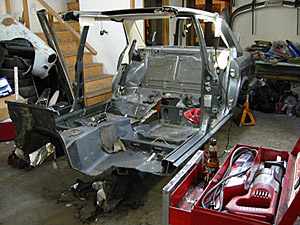 Two E28 535i’s were dismantled. Both cars, each wearing Delphin gray paint over pearl beige leather, were sacrificed because of their failed automatic transmissions. From the first we harvested the power door locks and windows, as well as the hydro boost power brake and steering system, for transplant into my friend Michael’s 1972 Bavaria. As we were loading the 535i carcass on to the trailer, it rolled forward and nearly pinned Michael between its front bumper and the tailgate of his Suburban. Note to self: Don’t load a car on to a trailer on a hill. The other 535i was stripped and Sawzalled as a donor for a race car project known as Frankenbav (a car story for another time).
Two E28 535i’s were dismantled. Both cars, each wearing Delphin gray paint over pearl beige leather, were sacrificed because of their failed automatic transmissions. From the first we harvested the power door locks and windows, as well as the hydro boost power brake and steering system, for transplant into my friend Michael’s 1972 Bavaria. As we were loading the 535i carcass on to the trailer, it rolled forward and nearly pinned Michael between its front bumper and the tailgate of his Suburban. Note to self: Don’t load a car on to a trailer on a hill. The other 535i was stripped and Sawzalled as a donor for a race car project known as Frankenbav (a car story for another time).
Which brings us to Sam the rusty parts car. In my heart, I know I should have just swapped all the nice parts into Chuck and used Sam as a winter beater. The heater and rear defroster worked well, the wipers were smooth, and the engine started well even when it was colder. But there was no time, and I needed four cars like I need a hole in the head. And then what would I do with Otto the 1991 318is? All rationalizations, I know.
Even in death, Sam behaved very well. When he came apart, the only thing that broke was one brake bleeder nipple. Everything else just came apart. The early E12s are a weird mix of later E12 and Bavaria, so the parts can be distributed between the two. Indeed, except for the dashboard and wood trim, the interior is going to a resto-mod 1970 2800 sedan. Still, I’m having a hard time with it.
Goodbye Sam, and thank you. Max and Chuck thank you as well.

